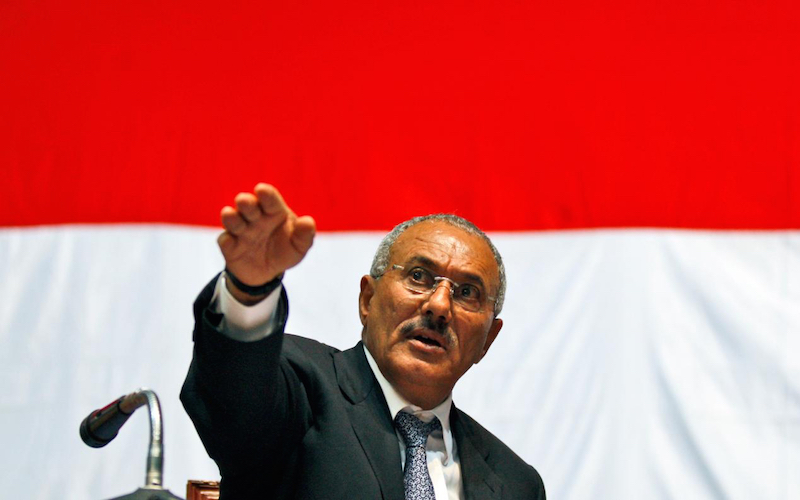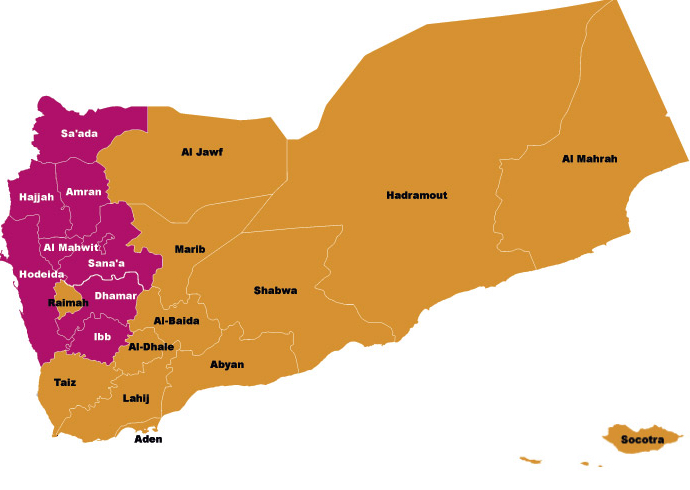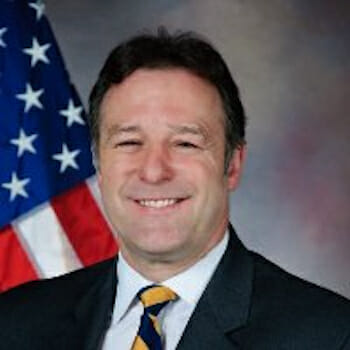
Yemen’s Three Futures
The Houthis and Al Qaeda on the Arabian Peninsula (AQAP) fighters have engaged in open street battles in Yemen. The death toll rises every day. The Houthis, like Hezbollah, their Iranian proxy in Lebanon, control territory. They have recently achieved unexpected victories. They seized Sana’a, the capital, the province of Dhamar – a city 100 km south of Sana’a – and they have captured the city of Al-Hodeida on the Red Sea and port at Hodeida. That is in addition to the provinces of Sada’ah and Amran which they captured in 2011 and July 2013 respectively. There are currently deadly skirmishes ongoing between the Houthis and tribal men loyal to the Islah Party in Ibb and between them and AQAP linked fighters in the city of Rada’a. From within the desperate chaos, we attempt to paint three futures for Yemen.
There is talk about a pause for what might be an agreement to end hostilities with AQAP and a withdrawal of the Houthis from some provinces. But just last week the Houthis agreed to the appointment of a new prime minister, Khaled Bahah. He was also endorsed by AQAP and tribal fighters loyal to the Islah party. Unfortunately, the Houthis eradicated government offices to establish a “Houthistan” – a Zaidi imamate – in north Yemen.
Discussions are underway about former President Ali Abdullah Saleh and other spoilers concerning enforcement of United Nations sanctions against them and also about Yemen’s Army starting to bolster its efforts to counter the Houthis and AQAP. At the same time the situation in the south is deteriorating with ever increasing protests.
Hiraak al-Janoubi separatists have set a deadline of November 30 for the withdrawal of government soldiers and civil servants because they want an independent South Yemen moving the country back to 1990. Yemen is arguably more unstable today than it was when former President Saleh came to power that very same year.
Yemen threatens to be the next breading ground and ungoverned space for turbulence and radical violence. Already the green shoots of the Islamic State (IS) are appearing in Yemen as an AQAP splinter. Supporters of the Islamic State in the Arabian Peninsula (SISAP) are publishing their presence in Yemen. Most Yemeni are frightened and focused internally. Most internationals are working to cut deals to bring peace to Yemen yet distracted externally by IS and the activities of the international coalition in Iraq and Syria. What next for Yemen?
Future One: ‘Rising Phoenix’
Some think former President Ali Abdullah Saleh will rise from the ashes like a phoenix and through his son – Ahmed Ali – rally the warring parties to bring an enforced peace to Yemen. The second Saleh Dynasty would therefore begin and the 2011 to 2014 period in Yemen’s history would be considered a misguided period of unrealized un-enlightenment.
Saleh II would rule with an iron fist. He would likely all but sever links with the west. Saudi influence would be restored to control tribes and maybe some limited military action would be necessary on Yemen’s northern border to control the Houthis. The death of over 2,000 so-called Arab Spring martyrs would be respected yet largely ignored. Some in Yemen believe the Saleh party, the General People’s Congress, can still muster enough power for a grab at the presidency. Some suggest Saleh is behind the current Houthi success on the ground and that without him they could not have succeeded.

Thus, Saleh is believed to be using them to get rid of his political rivals who revolted against him in 2011. The Houthi leadership rejects this notion but the United Nations appears to be thinking about sanctions against Saleh. Some in Yemen think ‘rising phoenix’ is a better future than the current situation. Some wish Saleh had never left.
Future Two: ‘Splinter State’
Some believe that Yemen will splinter and never recover. Yemen could divide into four parts: North, South, Central and Hadramout. The North would be under Houthi control and the South under Hiiraak control.
The Central swath would be controlled by AQAP and its new apparent affiliate SISAP. Hadramout would be controlled by the Hadrami people once they grow in strength. The borders of these four sub-states might be drenched in blood as each begins to fight each other. The international community seems ready to give up and back off. However, as U.S. drone strikes have continued it is hard to tell what the West wants in Yemen. In truth, if these terror groups are left alone, they will gather support and fight whenever the opportunity allows itself. Whatever happens politically, the international community will retain the ability to strike with drones any terror groups operating in these new sub-states.
AQAP and SISAP would likely see a splintered Yemen as an opportunity to push forward with their Islamic caliphate. Some in Yemen think that a splintered Yemen is the current reality.
Future Three: ‘Muddle Through’
Some think and indeed hope that the iron will be pulled from the fire and the crisis saved at the last minute by the Yemen government supported by the international community. Yemen always seems to ‘muddle through’ when other less robust states would simply implode. Many hope the international community can find a solution to prevent ‘rising phoenix’ and/or a ‘splinter state’ from occurring. It may be that ‘muddle through’ becomes the new norm for Yemen. Meaning that Yemen is in constant fear of collapse and from time to time it bubbles to near destruction and then miraculously in the nick of time someone finds a solution to hold Yemen together.
Whatever the potential future, Yemen has come too far in the last 3 years to throw it all away now. Despite the distraction from IS, Yemen is really hurting and the people are truly suffering. If we allow Yemen to deteriorate into a ‘rising phoenix’ or a ‘splintered state’ the international community will have failed. The Yemeni have placed a lot of hope in the international community to help them overcome the problems and challenges facing their country. Thus, the international community has to demonstrate a strong will to help Yemen implement the outcomes of the National Dialogue Conference which was agreed to and signed by all political forces in the country.
To abandon Yemen now would be a disaster. As our initial response to IS demonstrates, standing by and hand wringing does not cut it. We have to act now. Yemen is trying to form a government this week – despite likely opposition from the Houthis – and it must be given a chance to prove that it can work. United Nations action may have to be escalated to secure a peace. If the government cannot be formed, Yemen, a willing international partner, runs the real risk of falling into the abyss. ‘Muddle through’ is really the only option for Yemen.
Robert Sharp is an associate professor at the Near East South Asia Center for Strategic Studies and Dr. Murad Alazzany is an assistant professor at Sana’a University. The views expressed in this article are of the author’s alone and do not represent the positions of the U.S. or Yemeni government.
